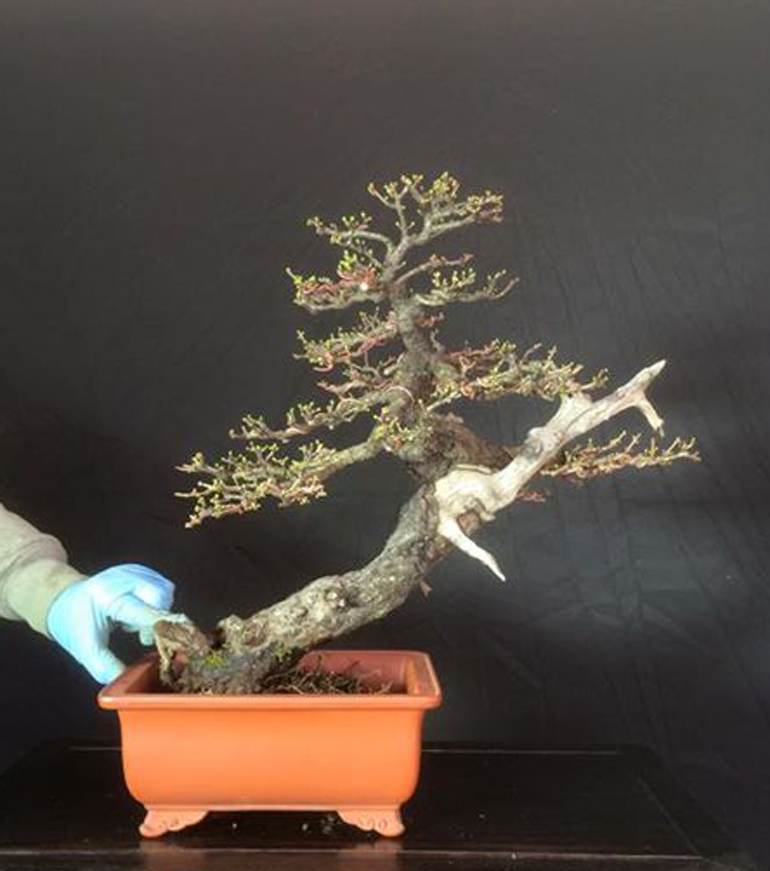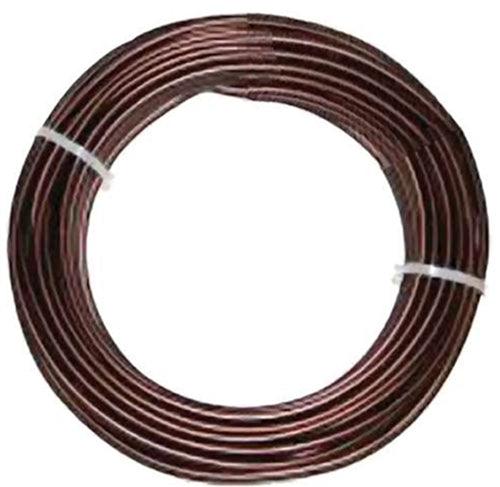Growing Pine Bonsai
One of the most famous Japanese white pine (Pinus parviflora) bonsai in the world. After restyling by Masahiko Kimura (aka the Magician). This photo is from the White pine gallery in our Masters’ Series Pine Book.
Continuing with our growing Pine bonsai theme… If you would like to grow pine bonsai, a good place to start (and continue) is with our Masters Series Pine book.
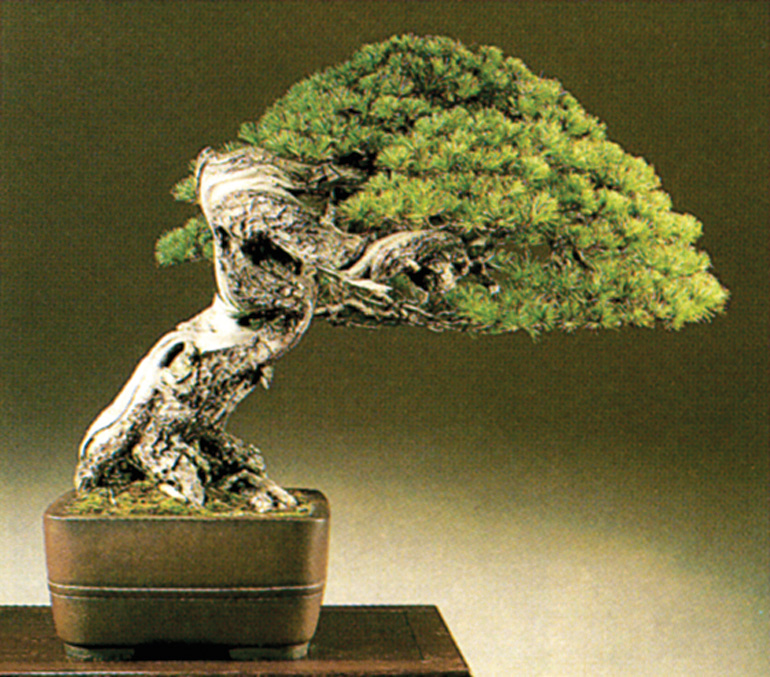
Pine Book Table of Contents
Introduction to Japanese White Pines
Kimura Transforms a semi-cascade using energy balancing & more
Cultivation Balance – Energy balancing and needle reduction
Goyomatsu – Balancing and redesigning
Kimura Plant Positioning – Nine possibilities, an in depth study
The Primary Branch – Selecting the best one
Multiple Trunk Bonsai – Three bonsai, three perspectives
Rock Planting – From to zuisho
Jewell to Whirlpool – Transforming famous old bonsai shari
Gallery of Japanese White Pine
TOC continued below…
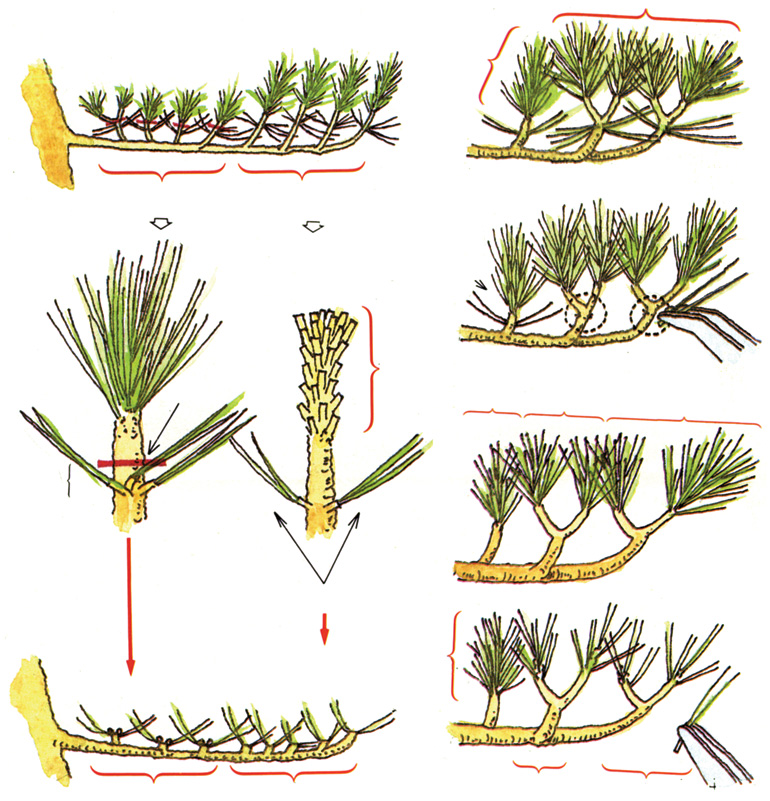
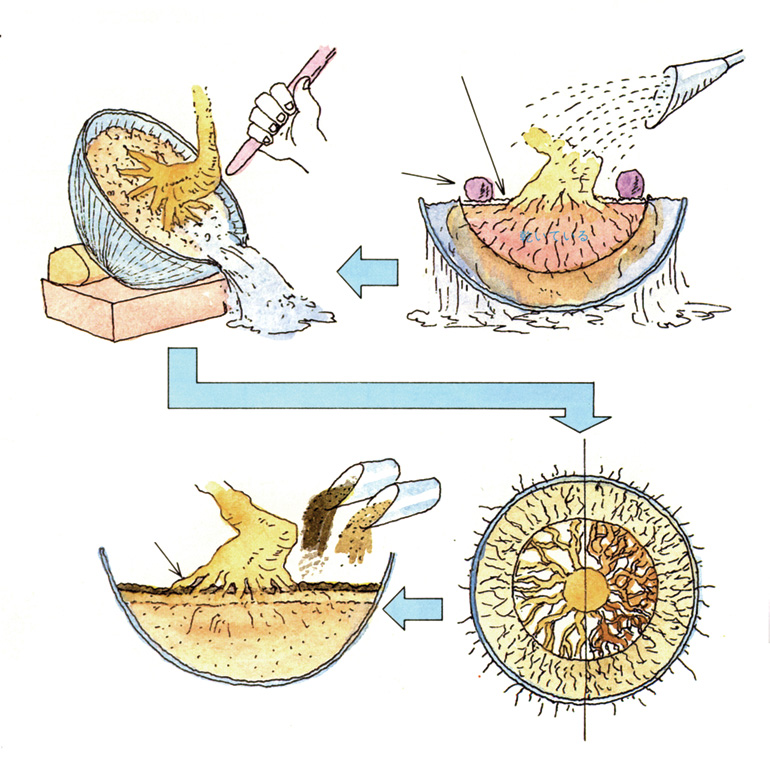
Table of Contents continued
Introduction to Japanese Black Pines
Development of Short Needles – Balancing growth & needle size
Creating a Cascade – Styling, balancing & needles
Choosing a Pot – Accentuating a tree’s best features
Transplanting and Nebari Development
Pine from Seed
Restyling an Old Tree – Challenges & rewards
Gallery of Japanese Black Pines
Glossary of Bonsai Terms
Glossary of Japanese Bonsai Terms
Growing and Styling Japanese Black & White Pines
is suitable for growing most pine bonsai
list price 34.95
Plucking & Pinching Some Extraordinary Pines
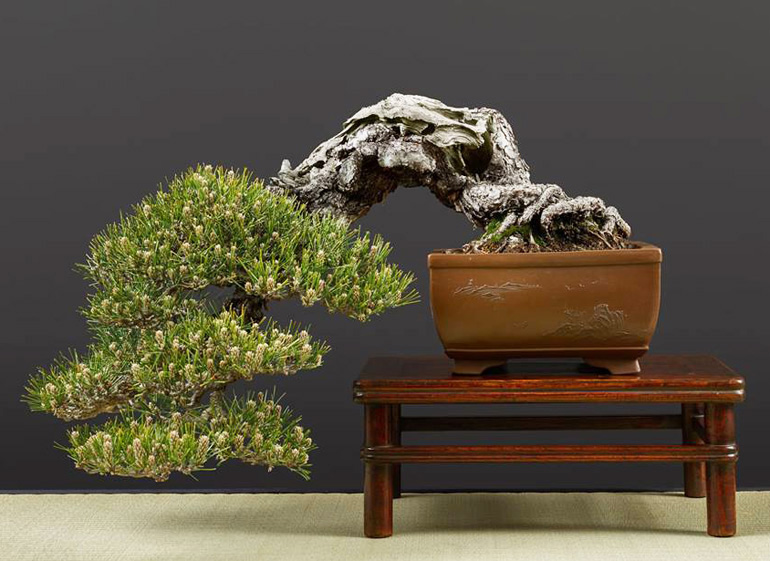
Not only is this an extraordinary cascading bonsai, but there's a story being told by the way the candles are strongest on the bottom third of the tree. Normally on apically dominant trees (like pines), you would expect the most vigorous candles at and near the top of the tree. My guess is that some of the upper candles have been pinched (shortened) and/or some have been plucked (removed) in order to control growth.
Disclaimer: I am not an expert on controlling and balancing energy on pines. I’ve done my best here based on what I’ve picked up over the years, but fear that I am oversimplifying what can be a complex process, with differences based on the type pine. For a more thorough look at candle plucking and pinching and energy balancing in general (and much more, you might want to take a look at our Masters Series Pine Book.
All the pines shown here were posted by Luis Vallejo. I imagine that all reside at Luis’ Museo de Bonsai in Alcobendas, Spain. Because we’re focusing on the candles and how they are managed in order to control and balance energy, I don’t say much about just how powerful and beautiful these trees are. But then you’ve got eyes, so we’re not too concerned. No varieties are given by Luis.
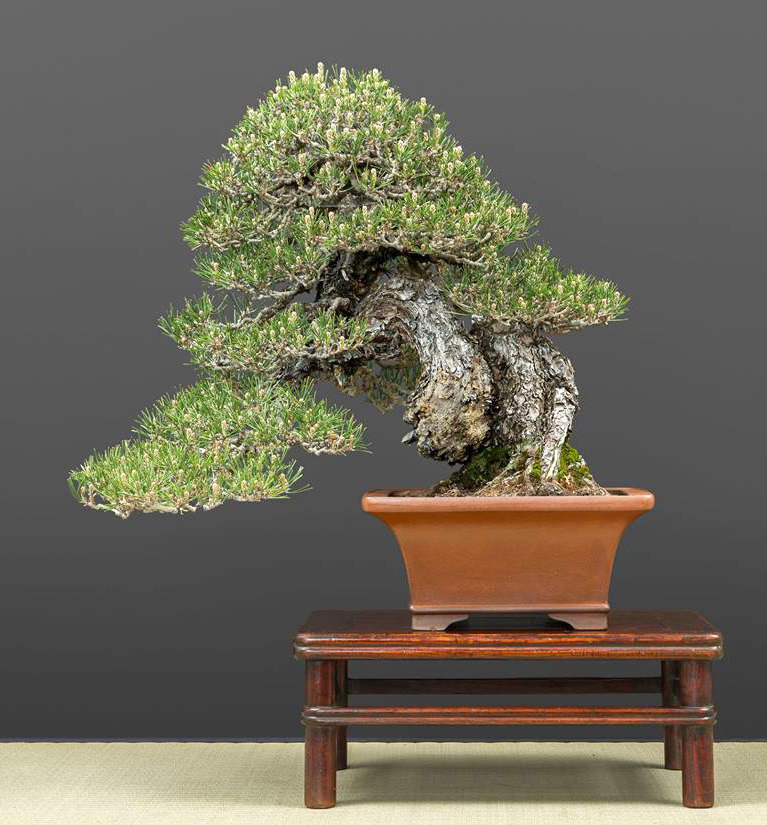
In this photo, the strongest candles are at the top of the tree. This is what you might expect if the candles haven't been plucked and/or pinched (yet). Conversely, but much less likely, the candles on the lower reaches have been plucked and/or pinched and those on the upper reaches have been allowed to grown unrestrained in order to strengthen the apex. The reason this is much less likely is that the upper reaches are almost almost always the strongest and the lower reaches almost always need strengthening or they will eventually weaken and even die. Just like you see on old trees in nature with dead lower branches and their strongest growth near the top.
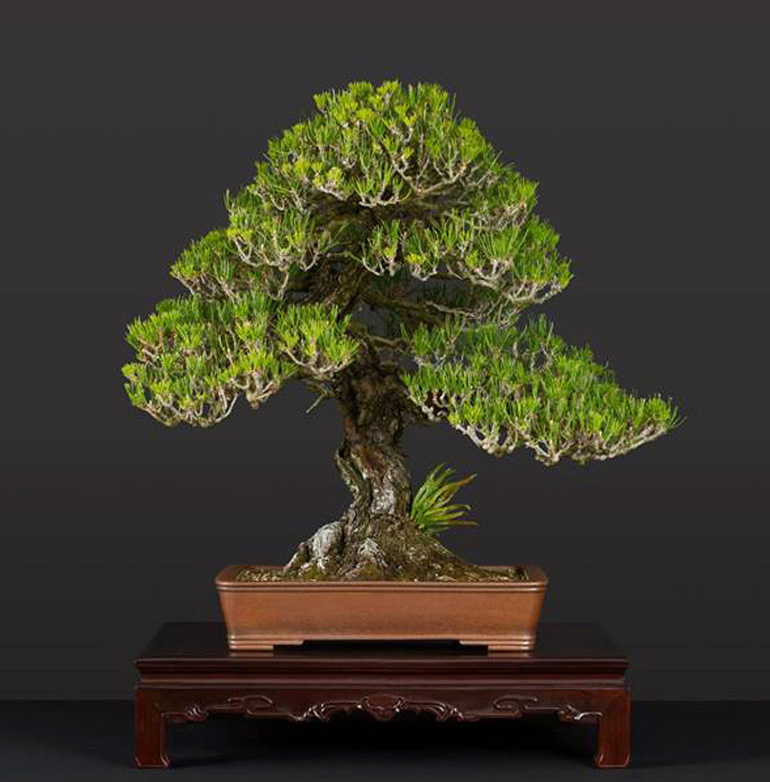
Later, after the candles have opened
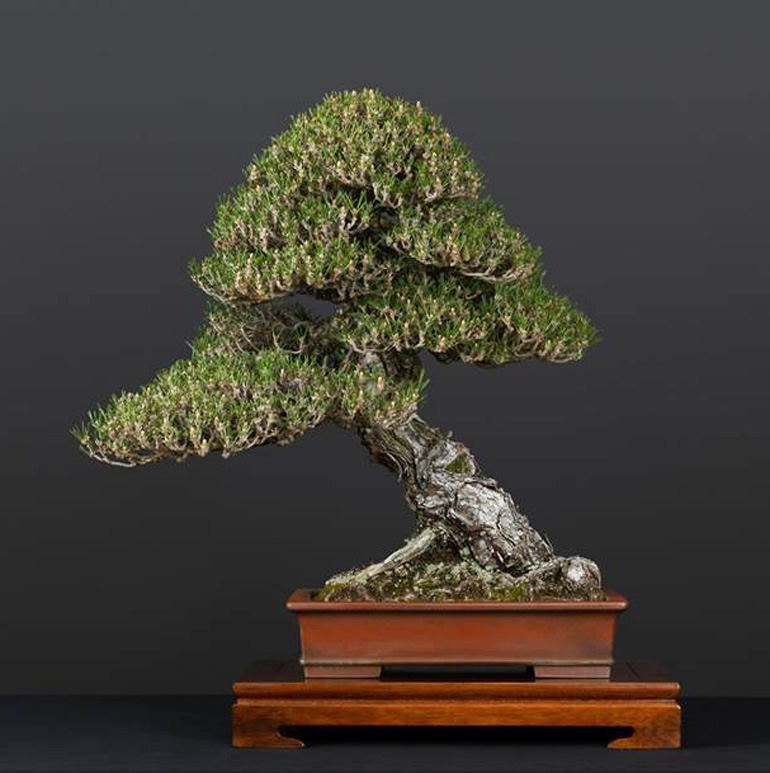
It looks like most of the candles on this one have been pinched and/or plucked in order to maintain an already well-balanced tree.
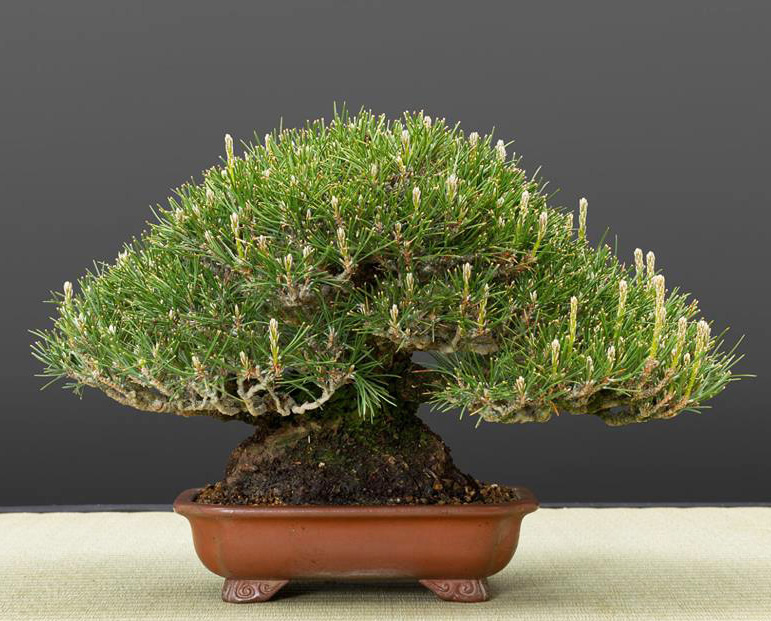
It looks like Luis (or whoever is working this tree) wants to strengthen the lower right section
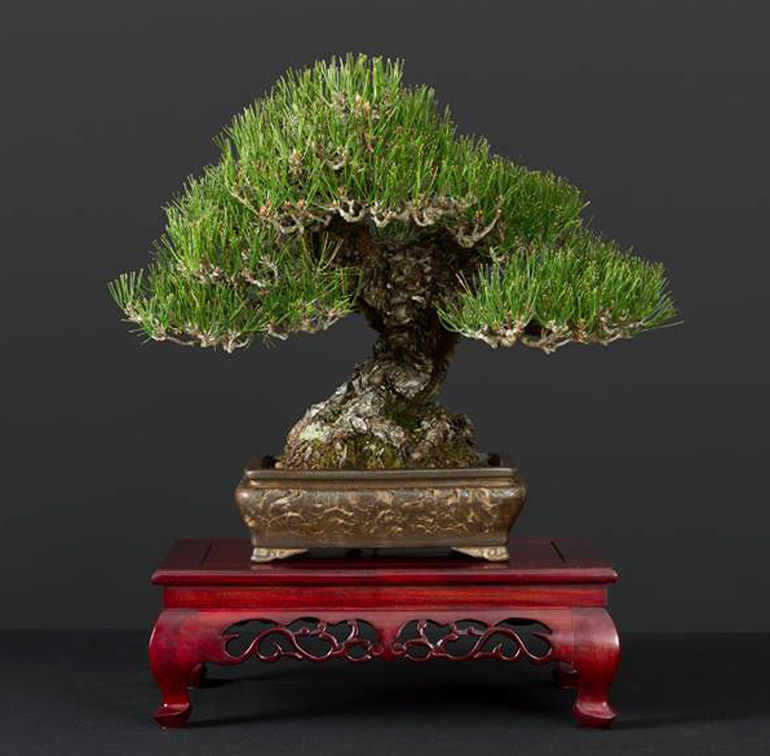
Another one after the candles have opened.
Mystery Bonsai Artist
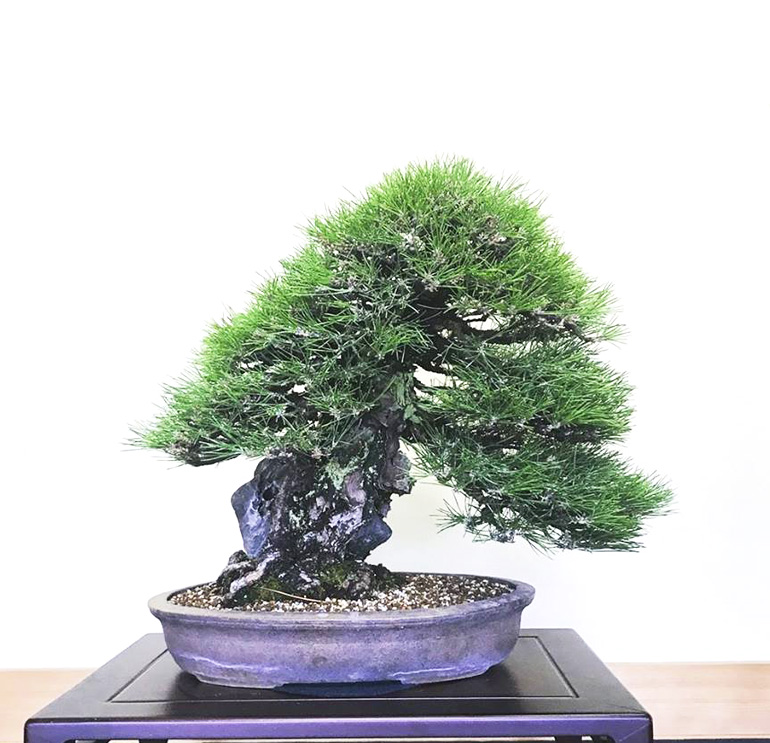
Here's what a machine translation from Japanese to English looks like... "70 times with kuromatsu stone, and the 77th Chinese National exhibition. 85 million yen. 15 years ago, when I was 32 years old, I applied for the first time in Japan's National Exhibition, and I was elected, and I was very jealous of this kuromatsu, and I was very good at it, so I was very good at it. I feel strange about what I have to doI have a sense of time becoming a successive goshinboku
" BTW Kuromatsu is Japanese black pine. In this case, it's a root-over-rock.
Continuing with Japanese bonsai (Hiroshi Kuni’s tiny trees yesterday) here are some trees that belong to an artist who’s name is a mystery (mystery to me anyway). I took a screen shot from their facebook page (just below) so that those of you who can read Japanese might be able to tell us who the artist is. If youknow, please email me <wayne@stonelantern.com> or better, put your answer in our Bonsai Bark facebook comments.

Here’s the screen shot from facebook. I hope I’m not missing something too obvious. In my defense, I just spent about thirty minutes in a failed effort to track down the romanized version of the artist’s name.
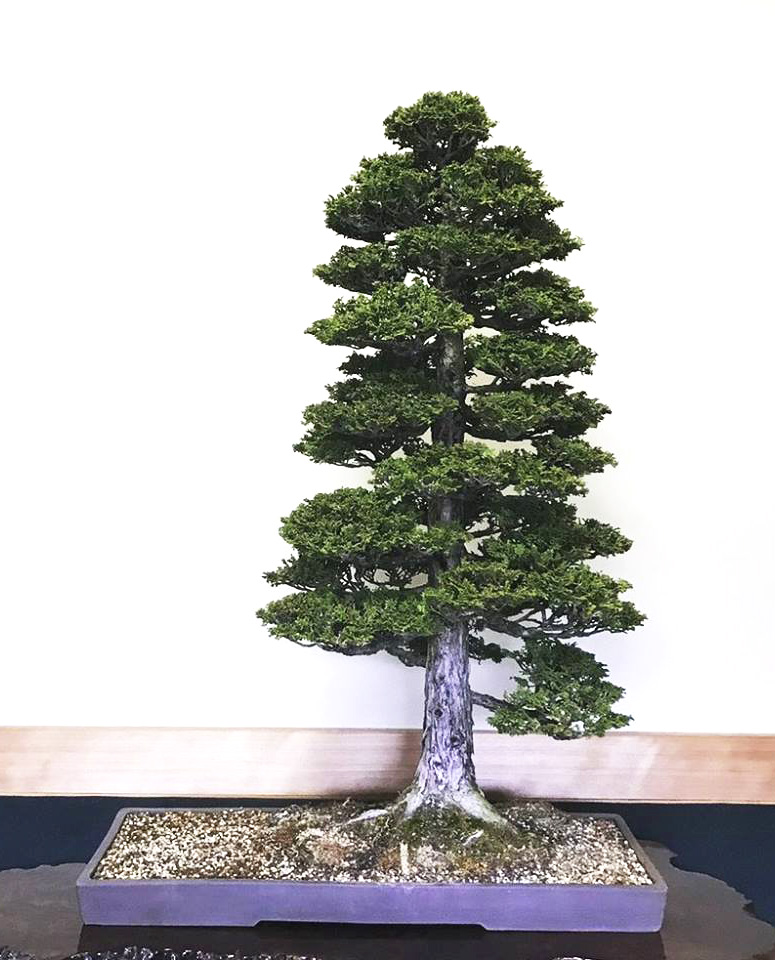
Here's the translation for this one... "Tsuyama Cypress?
? 110 cm
?
. — feeling entertained." I believe Tsuyama is a variety of Hinoki cypress (Chamaecyparis obtusa)
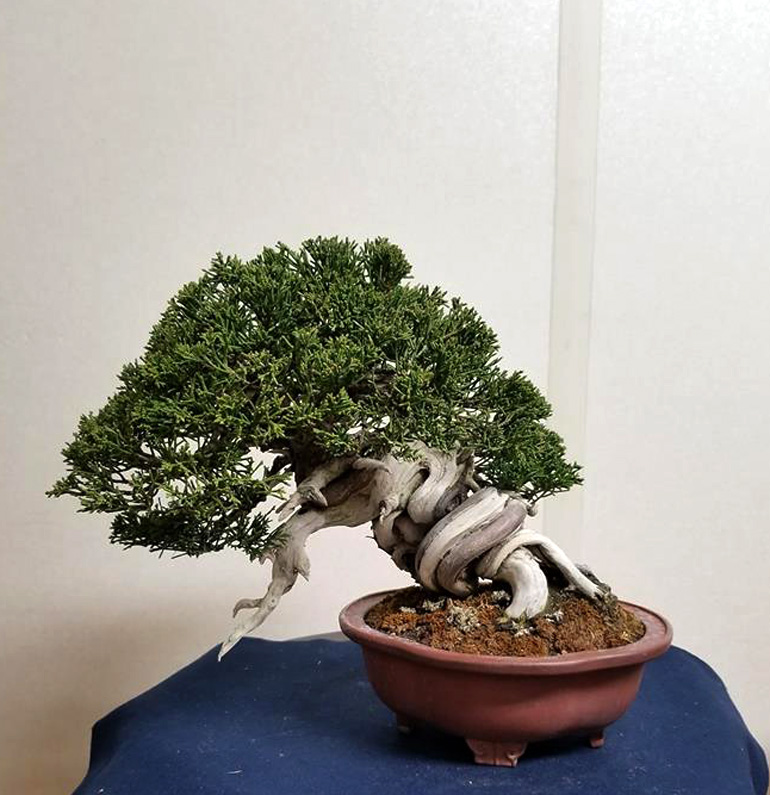
"Japan National Exhibition of 92 times. 38 million yen —feeling relaxed." Looks like a field grown Shimpaku juniper
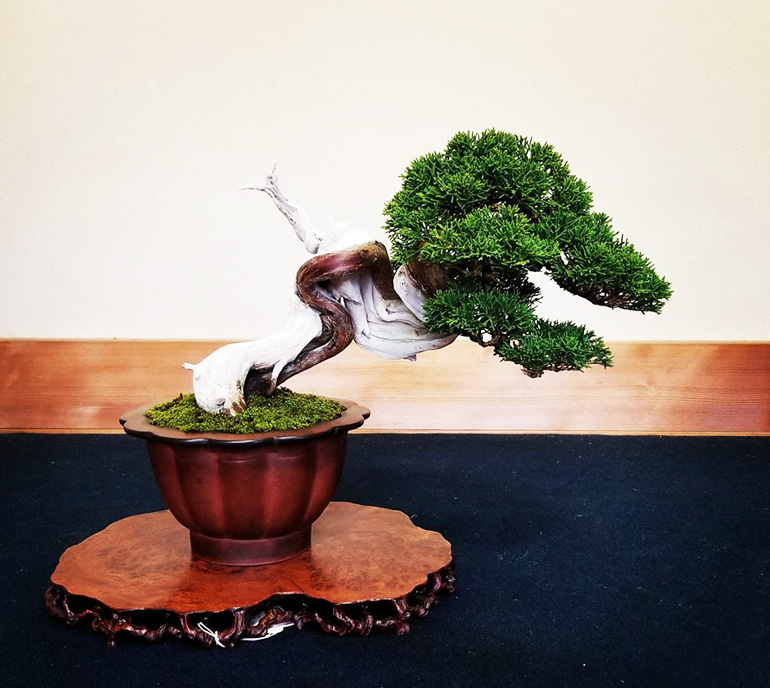
"It was a spring day today?
?—
feeling relaxed." Another field grown Shimpaku?
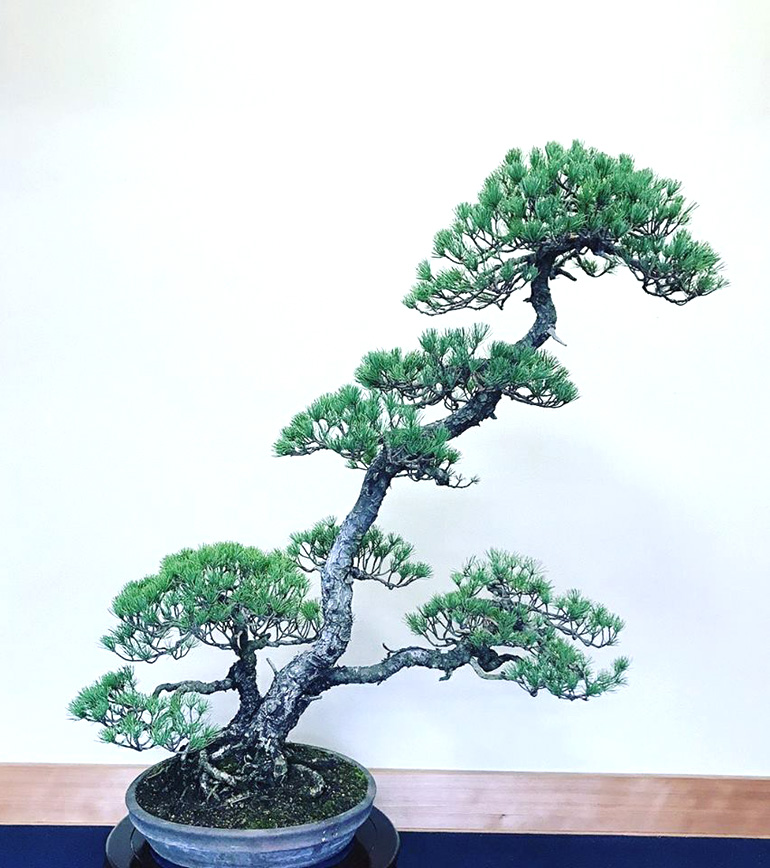
"W? yè s?ng. 38 million yen. Height 100 cm, for exhibition?
?—
feeling happy." Is this a Japanese five needle pine?
Hiroshi’s Bonsai Beans
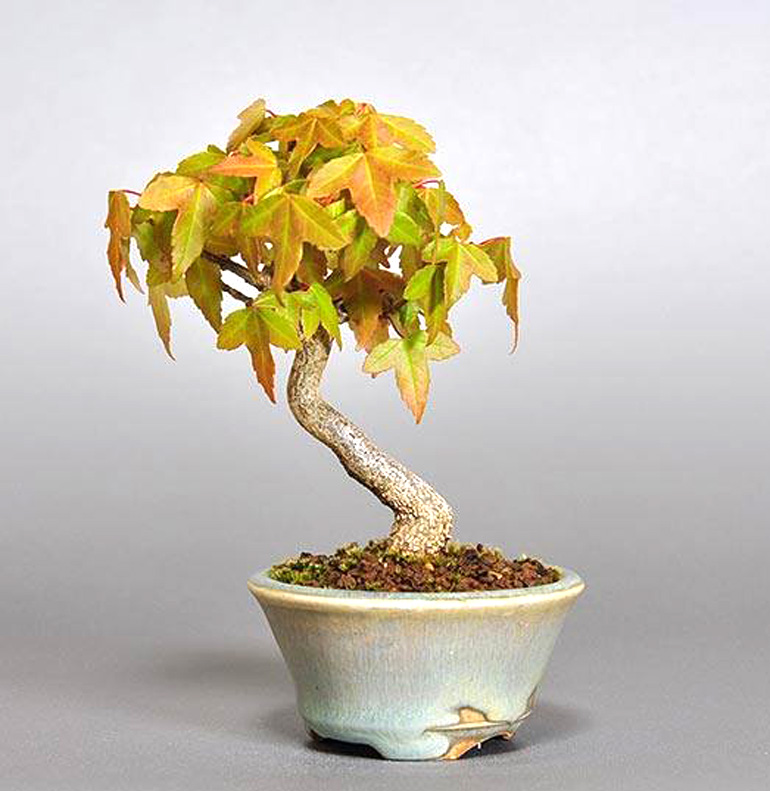
This little Trident maple (Acer Buergerianum) is just 10.8cm tall (4.3"). It was started from seed twelve years ago. Hiroshi is a potter, so you might assume that the pots shown here are his, though I couldn't make much sense of the translations provided with the photos. Hiroshi refers to the pots as a Maru Bonsai Bowl / Guó Jing Masako. Maru simply means round and I couldn't find anything when I searched Guó Jing Masako, though if you search Masako pottery you will get some results (where's Ryan Bell when you need him?).
We can’t stay away from miniature bonsai for long. This time Hiroshi Kuni’s tiny trees. If the name it familiar, it might be because we featured Hiroshi’s bonsai just four weeks ago. And just in case you’re wondering about the title, Mame a common name for miniature bonsai translates as ‘bean.’
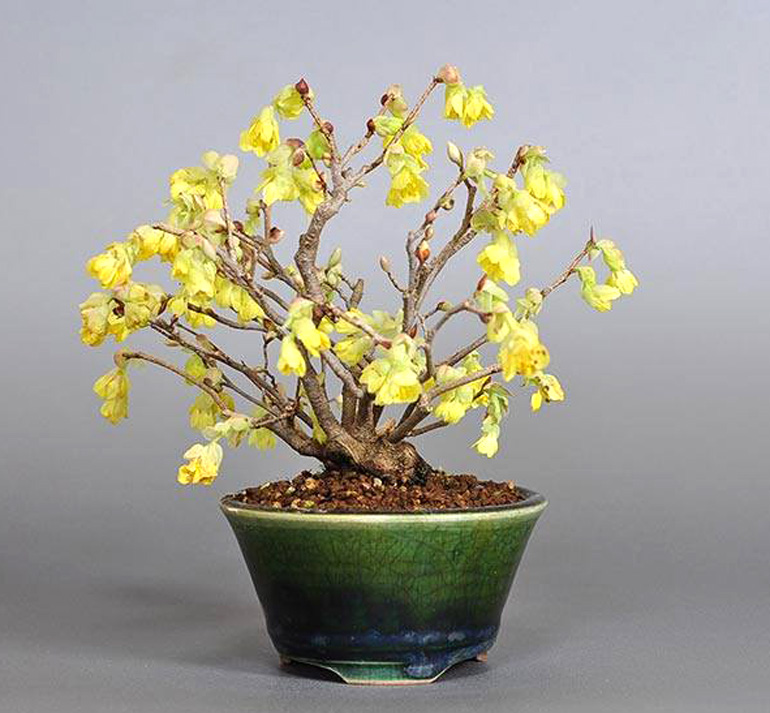
This one is a Buttercup winter hazel (Corylopis pauciflora). The Japanese name is Hyuga mizuki. The tree is 12.5 cm tall (5"). The information provided on the pot is the same as the information provided on the Trident maple pot above
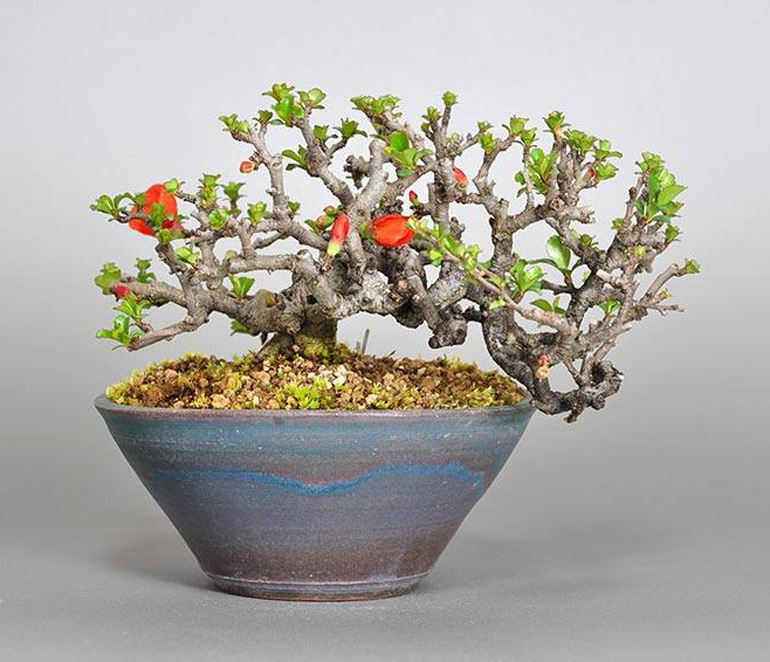
This Chojubai flowering quince (Chaenomeles speciosa var Chojubai) is just 9.5 cm tall (3.75"). See the Trident maple above for information on the pot.
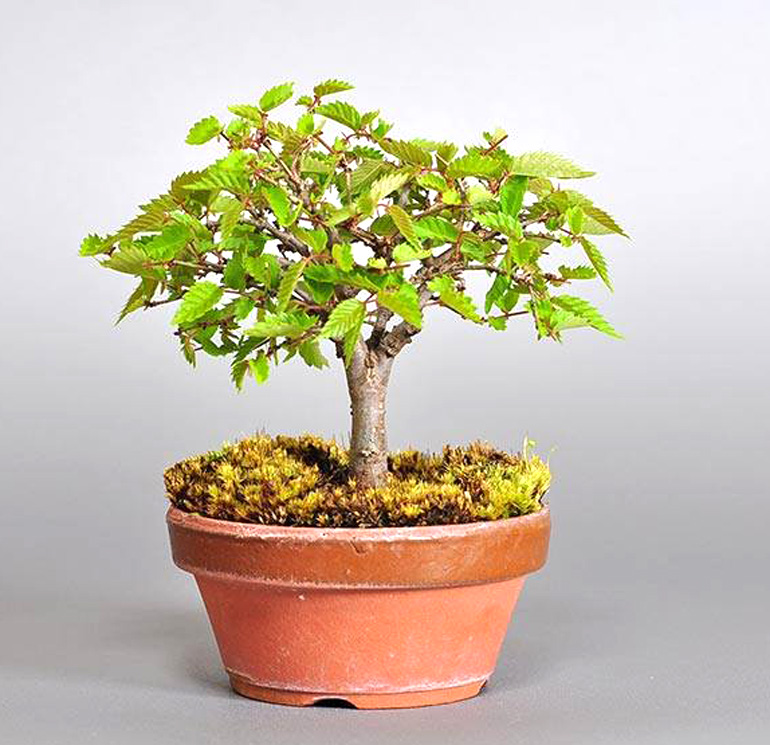
A broom style Japanese zelkova (Zelkova serrata) in a training pot. The tree is 10.3 cm tall (4")
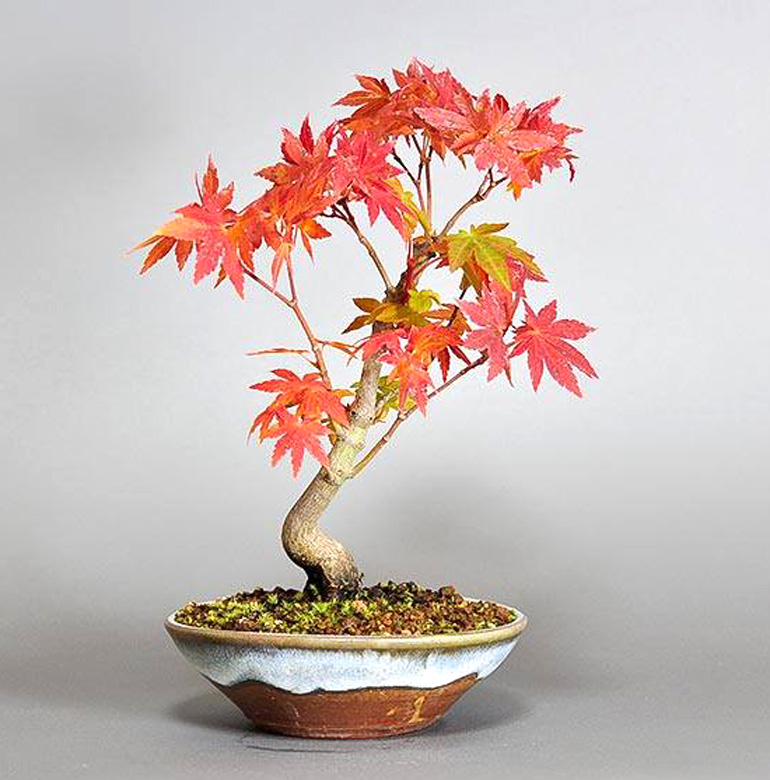
No variety, size or any other information is provided with this brilliant little Japanese maple.
A Little Bonsai History

This famous Chinese elm (Ulmus parivflora) planting is by Zhao Qingquan, reknowned penjing artist, teacher and author of two best Penjing books in the English, Penjing: the Chinese Art of Bonsai and Literati Style Penjing
Yesterday we featured a couple of events and photos from the Pacific Bonsai Museum. So, just for the fun of it, I thought we’d go back and find our earliest PBM post. It’s from April 21st, 2009, almost exactly 9 years ago. Way back in the day when it was owned by Weyerhauser and called the Weyerhaeuser’s Pacific Rim Bonsai Collection.
The two photos shown here were sent to us by David De Groot, who was the collection’s curator at the time. David is, among other things, the author of Principles of Bonsai Design, the most complete bonsai design book we’ve seen in over 25 years.
The two bonsai in this post, including this remarkable Korean Yew (Taxus cuspidata), are from Weyerhaeuser's Pacific Rim Bonsai Collection (now the Pacific Bonsai Museum).
Coming Soon, Brilliant Bonsai Fest at the Pacific Bonsai Museum
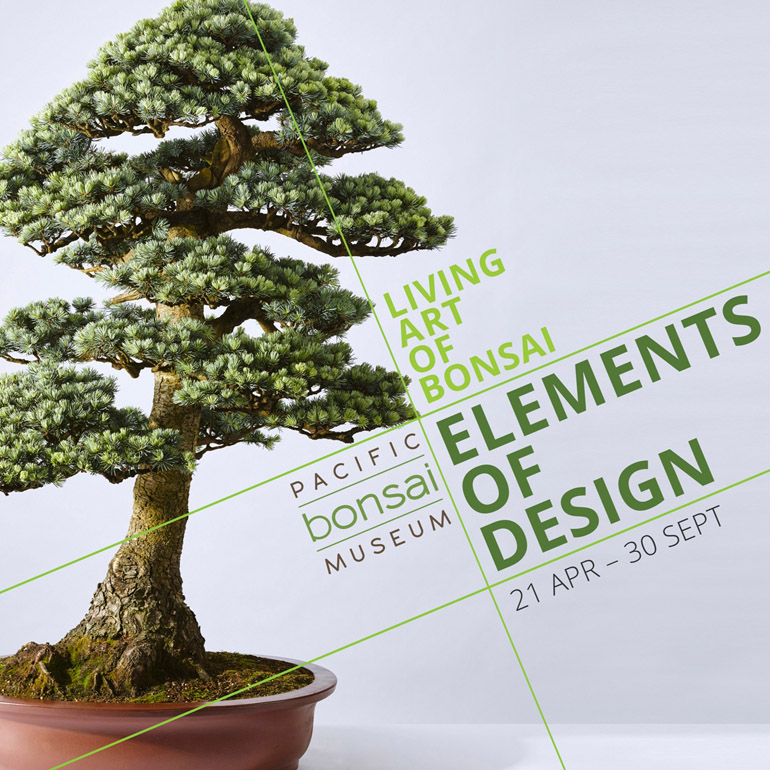
While you are visiting the The Pacific Bonsai Museum's Bonsai Fest (see below) you can enjoy their current LIVING ART OF BONSAI: ELEMENTS OF DESIGN exhibit. A perfect twofer.
Bonsai Fest! Comes to Federal Way. A two-day celebration over World Bonsai Day – Mother’s Day weekend
Details below…
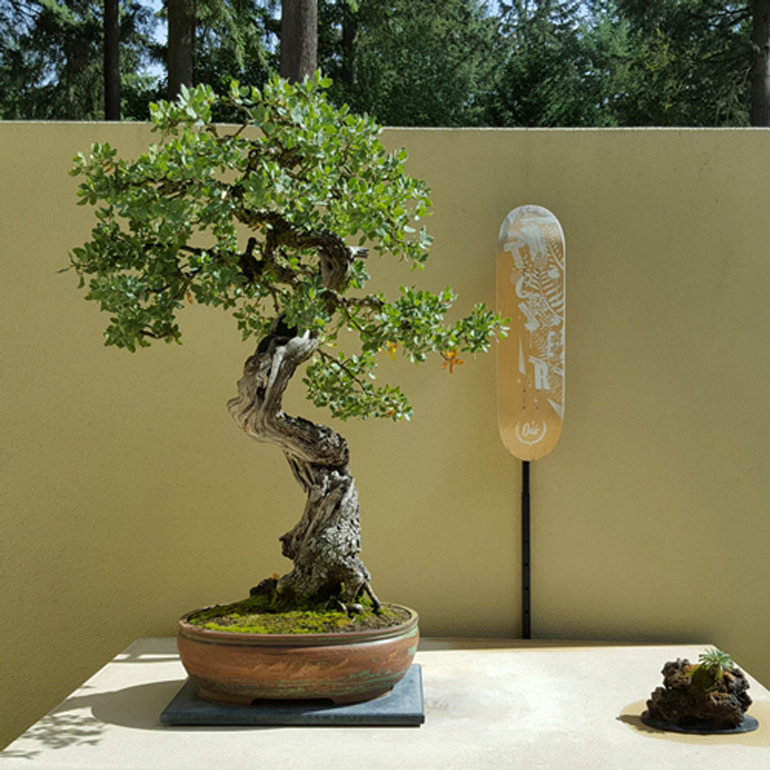
An Oak in one of the Pacific Bonsai Museum's many outdoor display sections. I couldn't find the variety, but the small leaves lead me to believe it might be a California live oak, or some other related live oak.
This May, Pacific Bonsai Museum hosts its first annual Bonsai Fest! The event features local bonsai enthusiast’s best works of art, as the Puget Sound Bonsai Association (PBSA) presents their member’s annual spring show. The public can view the club members’ bonsai, ask questions, and watch bonsai-making demonstrations. Demonstrations will be made by Tony Fajarillo–silver medal winning ‘Pot Party’ bonsai garden creator from the 2018 Northwest Flower and Garden Show–at 1:00 pm on May 12, and by Frank Heidt–longtime friend and student of Dan Robinson of Elandan Gardens–at 1:00 pm on May 13. Visitors can vote for their favorite PSBA bonsai to win ‘best in show.’ People’s choice voting concludes at 2:30pm Sunday with winners announced at 3:00pm.
Continued below…
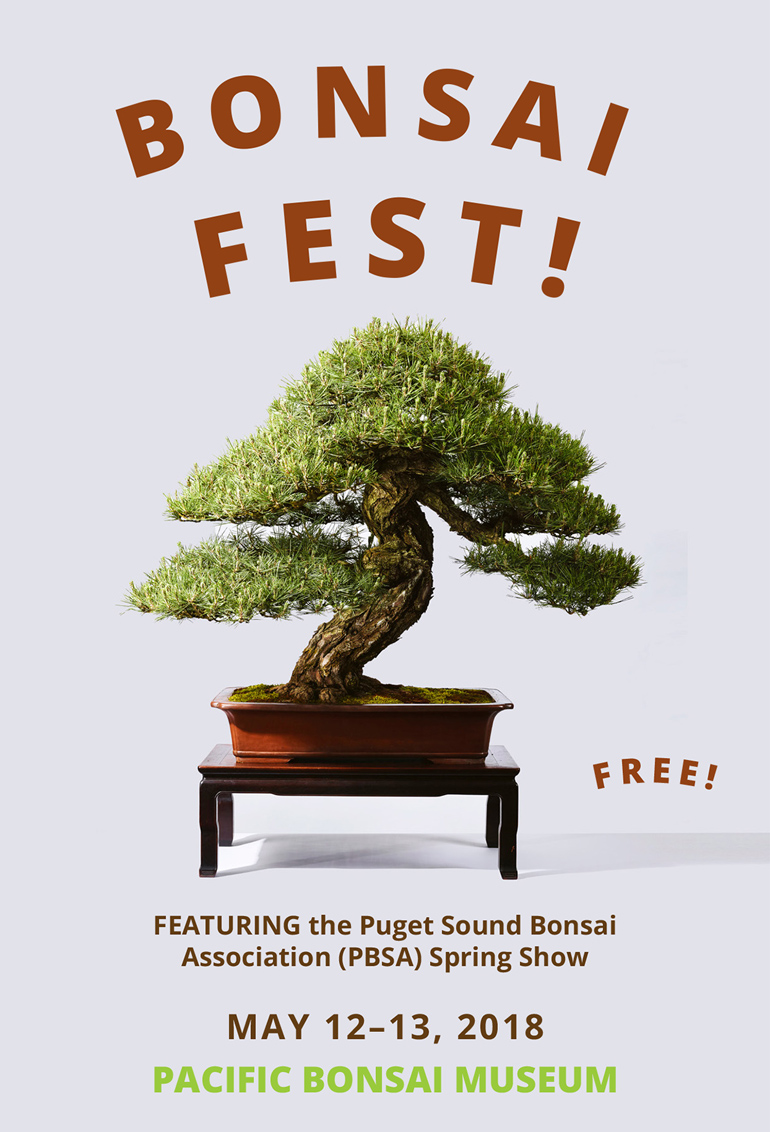
Continued from above…
Visitors can tour Pacific Bonsai Museum’s groundbreaking 2018 special exhibit ‘Living Art of Bonsai: Elements of Design’ that compares bonsai with other works of art and reveals the secrets of good bonsai design, breaking-down how exactly bonsai artists make tiny trees appear big, old, and interesting. Free, docent-led tours of the exhibit begin at 12 noon and 2:00 pm, both days. (Advance registration is not required.)
Bonsai Fest! offers visitors a pop-up shop where the inspired can buy their own bonsai to practice the art at home, as well as bonsai pots, bonsai books, and other gift items. Visitors can also enter a free drawing to win a bonsai tree. (The drawing winner will be chosen at 3:30pm Sunday.) An art station will be available to kids and adults who want to get creative and make cards for mom.
Continued below…
I couldn't resist showing this from last year's exquisite Natives exhibition at the Pacific Bonsai Museum. It's a a piece of a Mountain hemlock planting by Michael Hagedorn with a painting of Mt Rainer. For more you can visit two post we featured last December (here and here)
Continued from above…
On Mother’s Day–May 13–local poet Alexandria Manalo will be on-site from 11am to 2pm to writing complimentary, personalized poems for moms and other loved ones. Visitors can also pose at a bonsai selfie-station to take a photo with mom or snap a pic to share with her.
Main Street Gyro food truck will be onsite Saturday, May 12 and Chebogz food truck will be here Sunday, May 13.
Admission is free; $5 suggested donation for those who are able to support the Museum.
Saturday, May 12, 2018 (World Bonsai Day), 10am to 4pm; and Sunday, May 13, 2018 (Mother’s Day), 10am to 4pm.
In Praise of 3 Phenomenal Bonsai Tools & Another ‘Cedar’ Bonsai
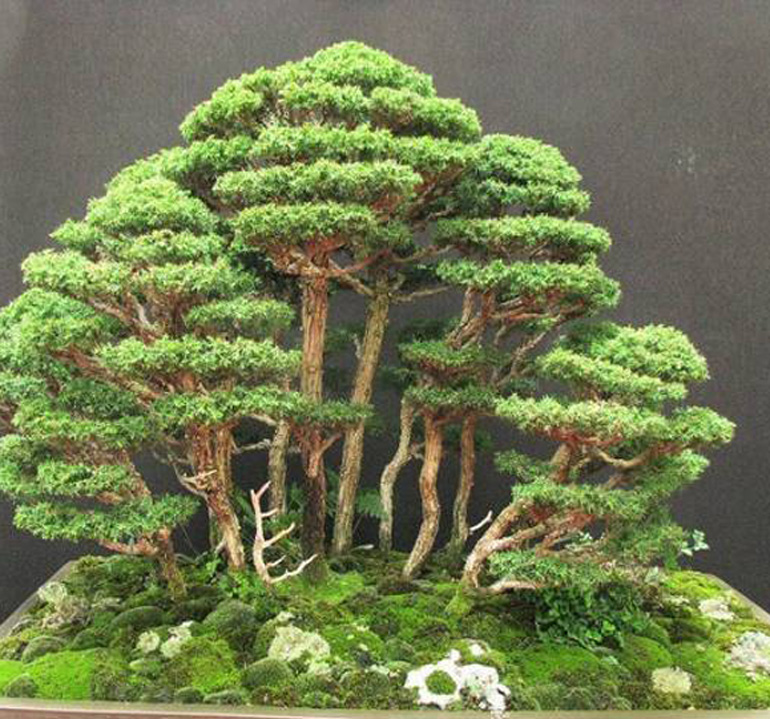
Close up of a Red cedar bonsai forest. I'm going to assume that it's what we call the Eastern red cedar, which is actually a juniper (Juniperus virginiana), though there are trees in other parts of the world that are commonly called Red cedar (none are Cedrus or true cedars). Our source, an online company that sells 'bonsai' seeds is no help with identification, nor with the owner of this forest.
I must admit I enjoy trying to sort out the common name versus botanical name confusion when it comes to certain trees. The other day we featured a Northern white cedar, which is really an Arborvitae (Thuja occidentalis) and a couple days before that we featured a couple Atlas cedars (Cedrus atlantica), which happen to be one of the three species of true cedars on this planet. Confused? Bored? Okay enough for now, but you haven’t heard the end of it
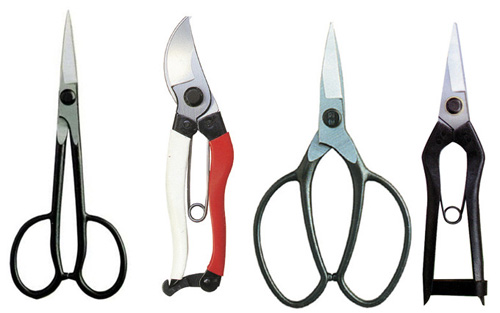
Four of my favorite Okatsune shears
all four cut like butter and last forever
I’ve been digging and potting dozens of field grown larch
the past few days and three of the four tools above are what I use
(along with a spade, root hook, Kamaki loppers, an Okatsune saw
and our Masters Grade Koyo Sword Shears)
.
In the image above, the one on the left is the Okatsune bonsai shear and it’s my favorite of all my bonsai shears. The one with the red handle is the 8″ Okatsune bypass shears which I use for heavy branches and roots and is simply the best bonsai/garden bypass shear I’ve ever used. The one with large loop handles is the Okatsune heavy duty hand snips, my root shear of choice for medium and small roots. I don’t use the Okatsune pine needle shears (on the right) for larches, though it’s also a great tool
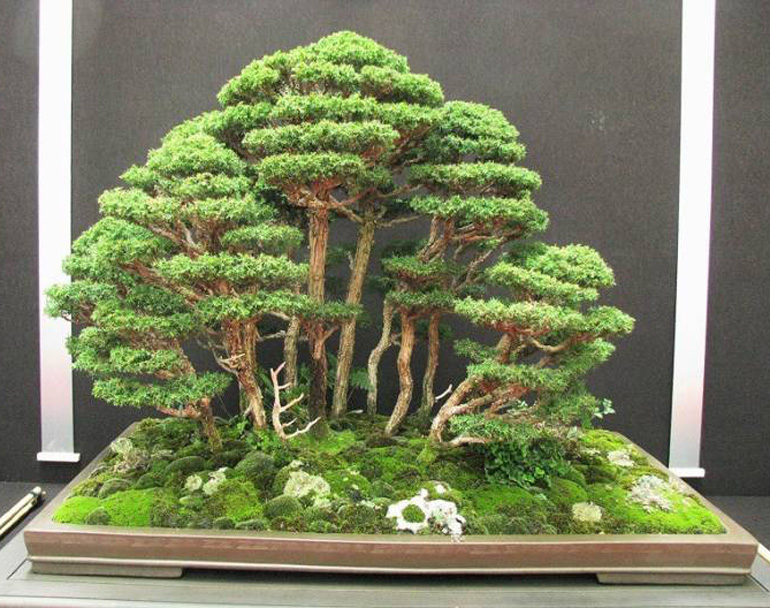
The uncropped photo of the forest above
American Larch Season
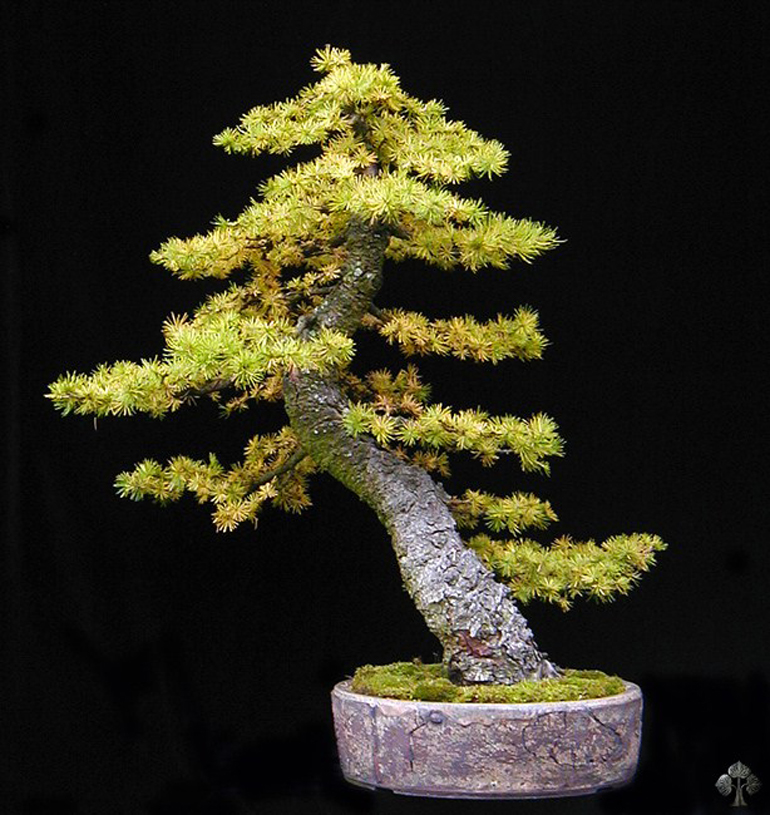
I found this photo in an article about larch at Bonsai Empire. No artist or owner is given. It's most likely a European larch (Larix decidua), though I can't say for sure. Here's a quote from the article... "The larch is a popular Bonsai species, since trunks grow thicker quite quickly and the tree displays stunning seasonal colors. Two common species exist, the Larix decidua (European Larch) and the Larix kaempferi (Japanese Larch)." Whoops! I think our hard working and normally knowledgeable friend Oscar (Mr Bonsai Empire) suffered a momentary lapse and forgot our American larch (Larix laricina)*, one of the very best species for bonsai (we've featured numerous over the years, including the one just below).
Still staying on theme with larches. I’ve been spending several hours a day digging, trimming and potting dozens of American larches (Larix laricina) that I’ve been field growing for years.** Some will come with us to the 6th U.S. National Bonsai Exhibition in September, the one North American Bonsai Exhibition not to miss. I hope to see you there!
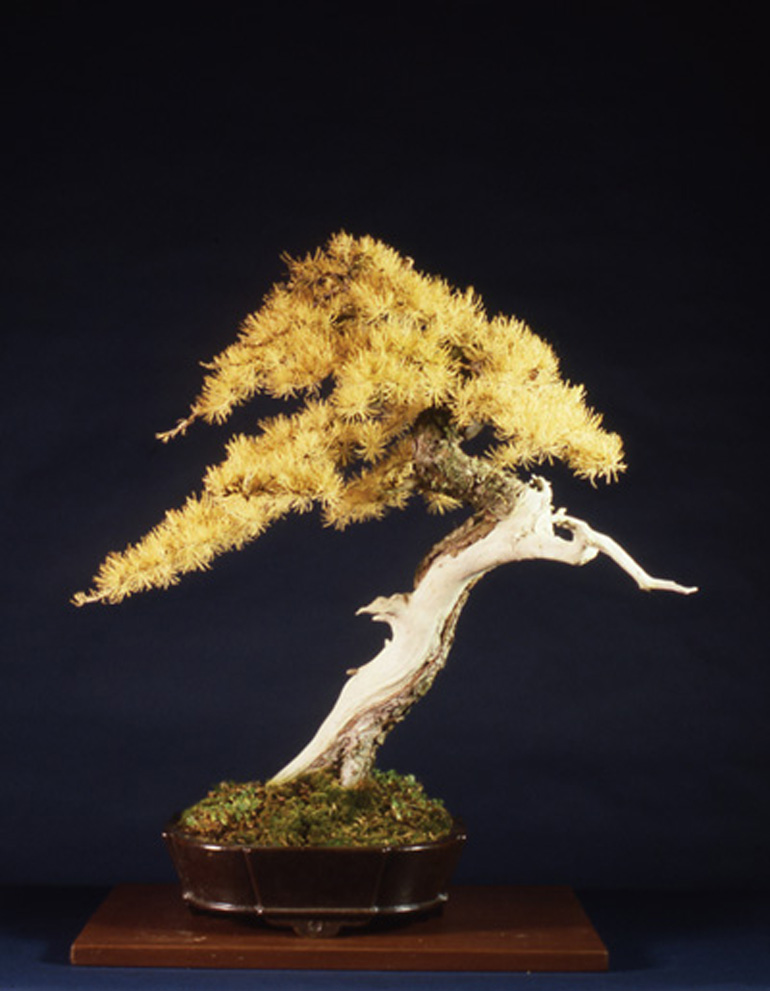
A famous American larch (Larix laricina) in full fall color. The artist is 'Larch Master' Nick Lenz.We originally featured it in post titled In Praise of the American Larch: aka the Tamarack way back in October, 2009. BTW, this tree is massive. Much bigger than you might think based on this photo.
*In Oscar’s defense, he was most likely writing for a European audience who may not have access to our American larch
** Our field grown larches will all be in nursery containers and though they have been grown and trimmed over the years for bonsai, most are still fairly rough. Perfect for the do-it-yourself bonsai artist/enthusiast who is ever vigilant in their search for good material.
Boreal Bonsai King
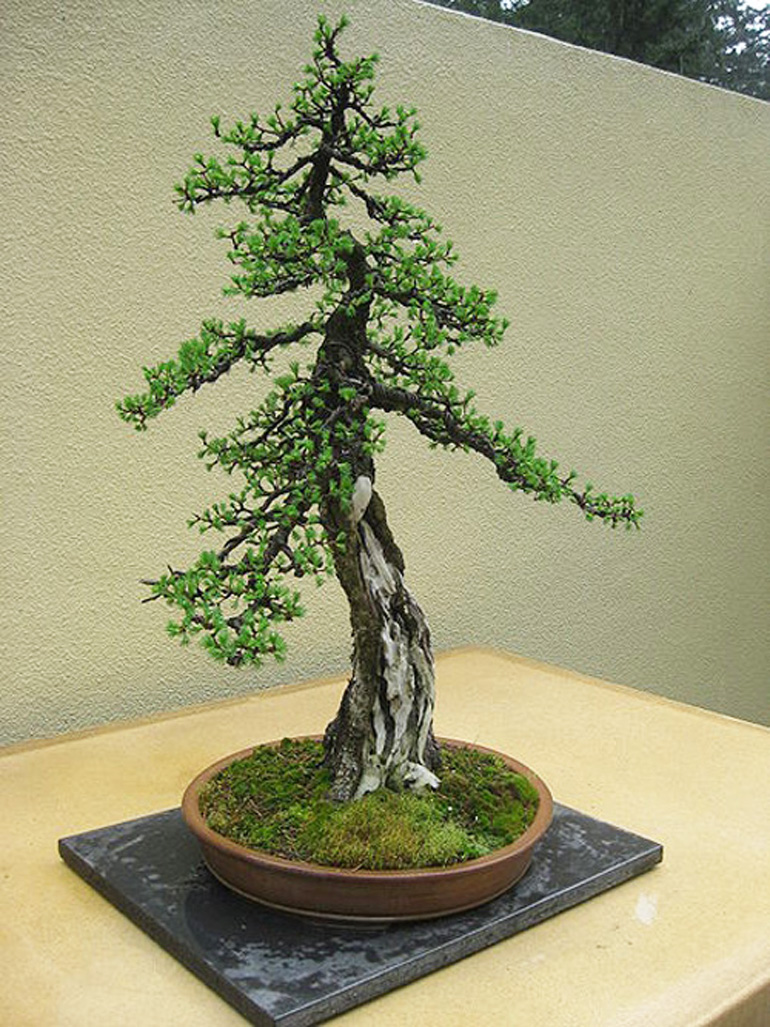
One of Nick Lenz' famous larches. The larches we'll be offering this fall (see below) aren't this old or nearly this refined (Nick is in a league of his own), but they are off to a good start.
Monday morning, the sun is shinning and buds are just starting to swell. Spring digging season won’t last, so it’s time to get outside.
Continuing our Larch theme, yesterday I dug, trimmed and potted (nursery pots) a few of the larches I’ve been growing on my land for the last dozen or so years. Most are around 20 to 25 years old (they started on a friend’s land up near the Canadian border). By the time I finish digging I should have about 40 or so that will be ready to sell at the 6th U.S. National Bonsai Exhibition this September. See you there!
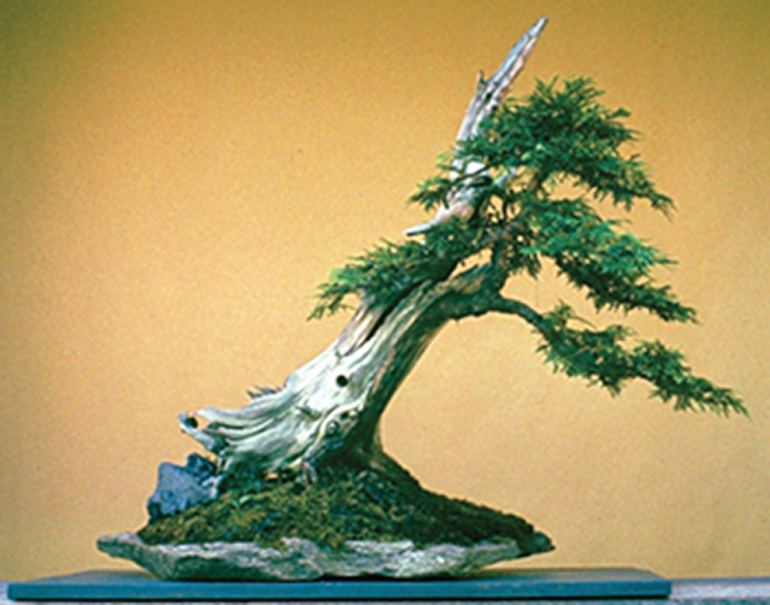
This Northern white cedar (Thuja occidentalis) is the cover tree from Nick's book, Bonsai from the Wild (out of print). Though larch is the bonsai king of our New England natives, we've got some pretty good cedars too
Boon’s Tamarack and 4 Pots – Which Do You Prefer?
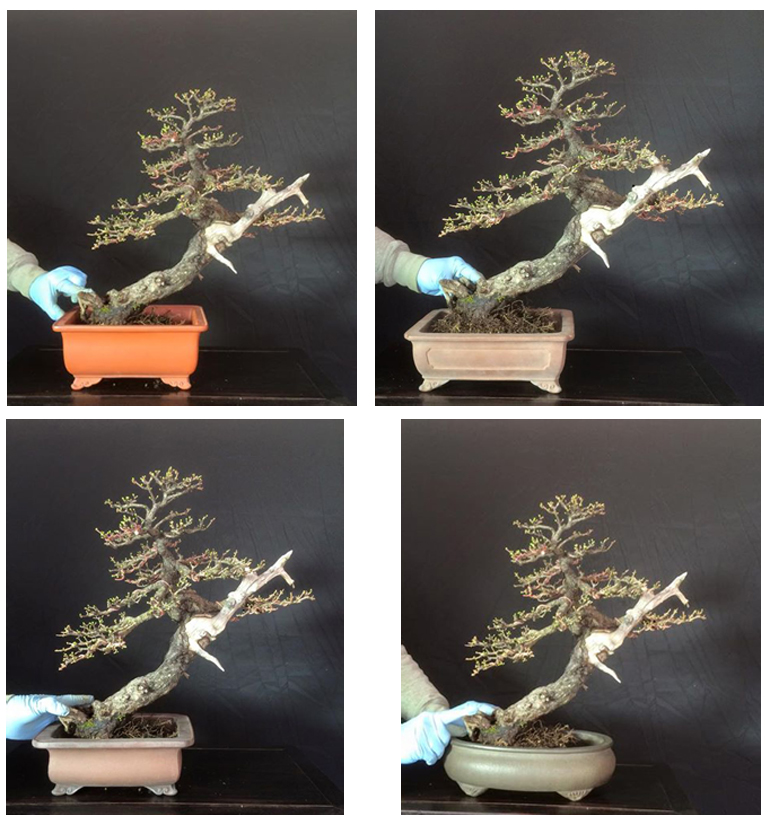
One American larch (Larix laricina) and four pots (plus the original). Which do you prefer? All this images in this post were borrowed from Boon Manakitivipart (the image above is a composite that we put together).
Yesterday, April 21st was our first day of spring here in northern Vermont (not technically, but really), so I started digging up some Larches I’ve been growing in the ground for the last 10 to 15 years and putting them into nursery pots. My plan is to take some of them to the 6th U.S. National Bonsai Exhibition in September. Anyway, my mind is all larches right now, so I thought I’d dig up (pun unintended) this post that we originally featured April, 2015.
Boon is at it again. This time it’s our prized local larch (Larix laricina). Around here we call it Tamarack (the Algonquian name that means “wood used for snowshoes”). No matter what you call it, it is in my opinion, by far our best local wild species for bonsai. Bar none.
Here’s your link to Boon’s original photos on facebook.
Continued below…
Pot number 1
Continued from above…
Which pot do you prefer? If you are ambitious, you might tell us why. (NOTE: So that everyone can benefit from your observations, please put your choice in the comments on facebook. Please DO NOT email me with your choice.)
BTW: the more I look at this tree, the more I think it is very possible that it was originally collected and styled by Larch Master Nick Lenz. I might be wrong, but…
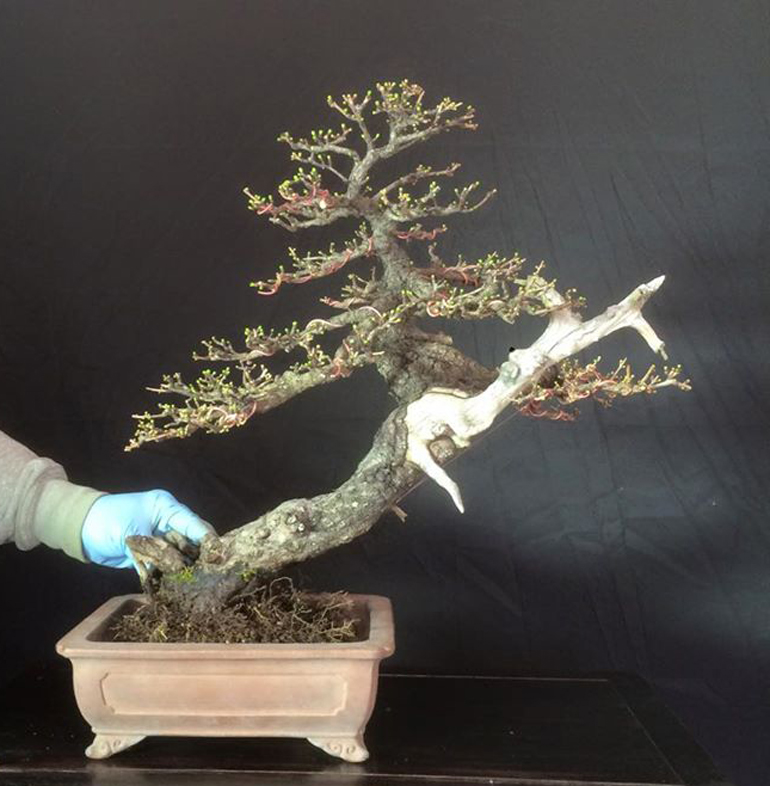
Pot number 2
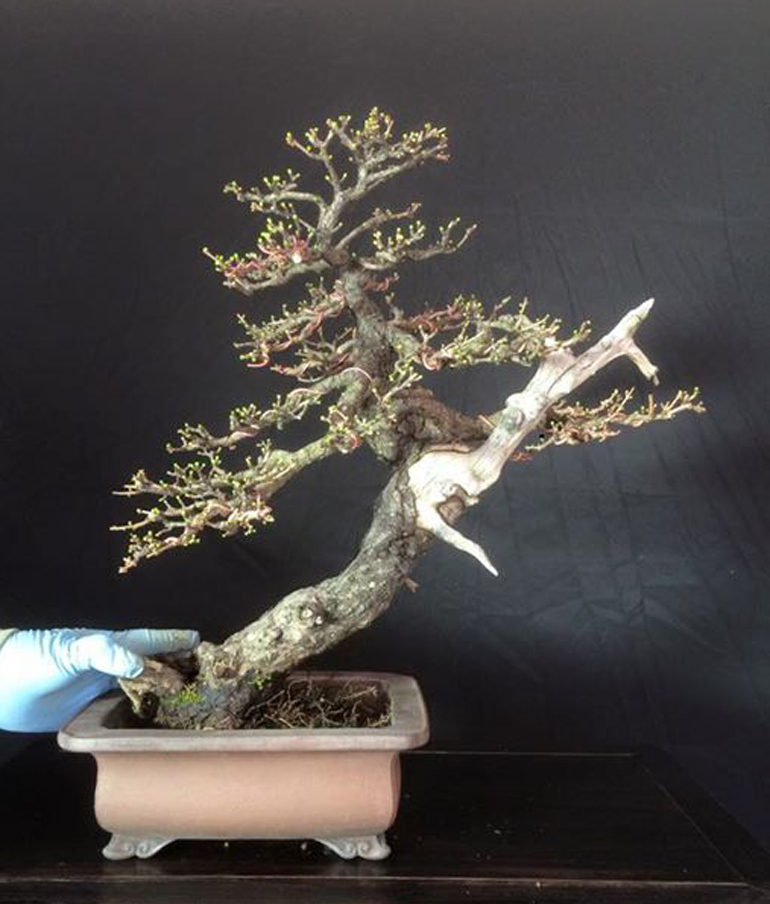
Pot number 3
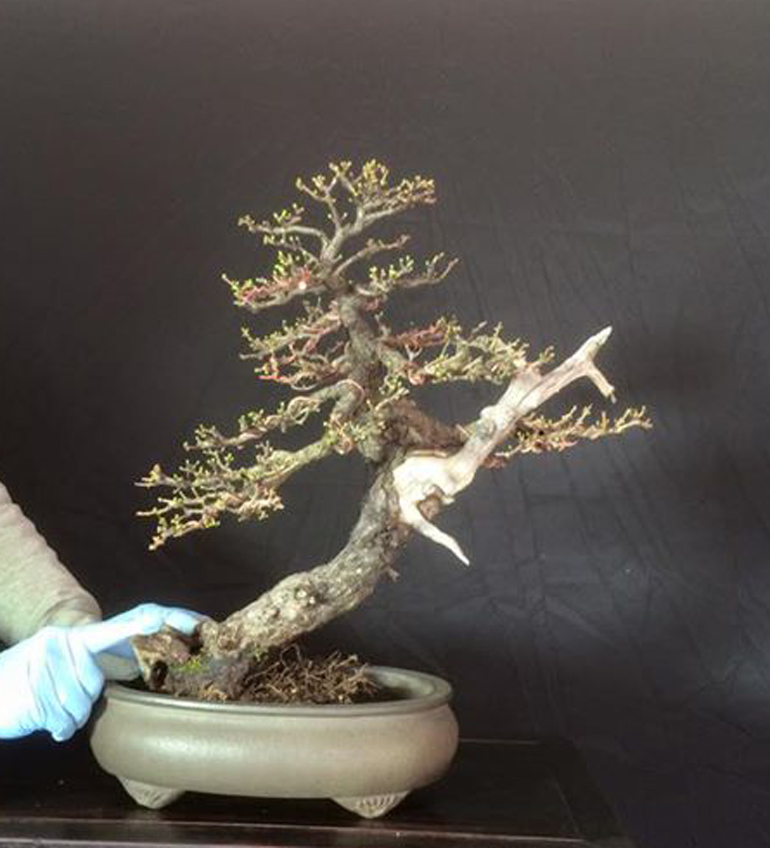
Pot number 4
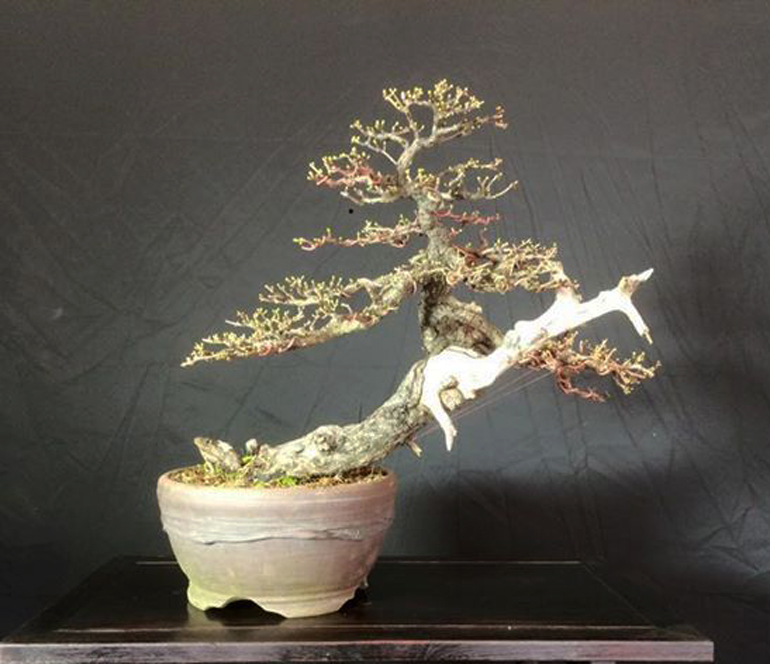
The original pot.

